OPINION
Recovery strategy: construction, manufacturing, tourism
The Innovation Economy thrives on exporting products made in Washington by advanced manufacturing firms staffed by the most highly paid and highly skilled workforce in the world. This brings home the cash to circulate in our economy, to construct public infrastructure and private development, making our state the most attractive tourist destination in the world.
Our state is home to more than 7,154 manufacturing firms with jobs that pay an average of $77,000 annually. These are mid-market firms that have survived the startup phase and are ready to expand. Just as Boeing searches the globe for advanced orders, the mid-market firms can also expand their workforce when they obtain advanced orders.
Innovation in marketing, competitive intelligence, scouring the globe for customers, securing future orders is what an expanded business services could accomplish as part of the innovation economy; innovation in trade and logistics — how we ship our products around the globe is part of the innovation economy.
High-wage jobs that require highly skilled workers exist at places like Boeing, Microsoft, in construction and the other 7,000 manufacturing firms looking for workers. While there are openings in the manufacturing firms, unemployed workers who could potentially fill these positions aren’t trained for them. Firms that need to upgrade their manufacturing processes have access to Impact Washington, our state’s Hollings Manufacturing Extension Partnership.
Some 90,000 unemployed manufacturing workers need training in Lean and Six Sigma, in Mechatronics and 3-D Printing and composite construction, in computer-aided design, in advanced machining. Washington state community and technical colleges are the world’s greatest workforce training sites for preparing workers for their next career in advanced manufacturing in our home state.
An economic development strategy based upon patents which are manufactured in newly created jobs in China is not a strategy for economic recovery or job creation in the State of Washington. Venture capitalists become multi-millionaires by manufacturing in China and selling back to the United States but do not create jobs for Washington workers.
The health of Washington state’s economy is not measured by the number of millionaires paying income tax because we do not collect income tax. We do not collect property taxes on their intangible property, nor do we tax capital gains. This state survives on its businesses and citizens paying sales taxes and B & O taxes. It only makes sense, therefore, that our strategy for economic recovery would create jobs and expand firms to enable employers and employees to purchase durable goods in order to generate these taxes.
The Department of Commerce’s Division of Business Services, and Western Washington University’s Center for Economic Vitality know how to scour the globe searching for orders for our businesses. We need to expand those activities, not cut their budgets.
Putting construction workers back on the job means spending on public works. In good economic times, private sector construction accounts for about 70% of construction work. During this great recession, public works spending on public projects represent 70% of construction work and can prime the economic pump. Economic recovery will come when the “Carhartt Cluster” is off the bench and back on the job repairing and building our infrastructure.
Prior to the great recession, over 10% of the total private sector workforce was employed in construction. Some 234,980 workers were employed with a total payroll over $10 billion. Direct sales taxes were $1.6 billion, plus $262 million in B & O, paid directly into the general fund.
Now, four years into the recession, more than 50,000 unemployed construction workers are ready to go to work. Each million dollars invested in new construction in Washington generates $1,970,000 in additional sales; and 16 new jobs. We need to pass those bonds bills to put these workers to work.
When tourists come to our beautiful state, they bring their money, spend it and go home leaving us with an instant cash infusion to our economy in our hotels and restaurants. Jobs in the tourist industry are not has highly paid as construction or manufacturing but they provide the anchor for importing tourist dollars. Total employment directly generated by travel spending in 2009 was 147,000 jobs in every community in our state. The legislature should expand the tourist budget not eliminate it.
Manufacturing for export, construction, and tourism are all vital components of a strategy for economic recovery. Each of these sectors can put our people back to work with a little help from all of us. These sectors are found in every community in our state and can drive the engines of economic recovery.
We know that the tax system is not the determining factor for expanding or siting a factory in a particular location. The determining factor for siting a factory is the quality and skill of the available workforce.
Low-skill, low-wage factory jobs will probably never return from the outsourced location. But the availability of the most highly skilled workforce in the world will attract advanced manufacturing firms upon which economic recovery will occur. Workers and businesses are in this Great Recession together and together we will work our way out of it!
Sen. Maralyn Chase (D-Shoreline) represents the 32nd Legislative District, which includes north King and Snohomish counties. Contact her at maralyn.chase@leg.wa.gov.






